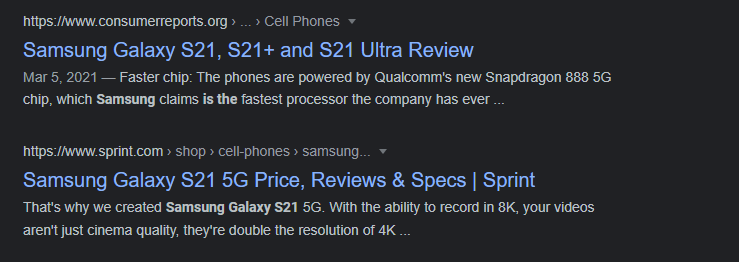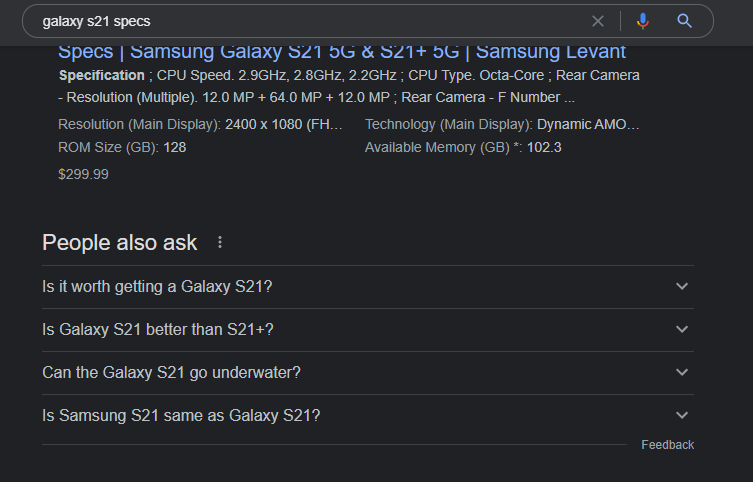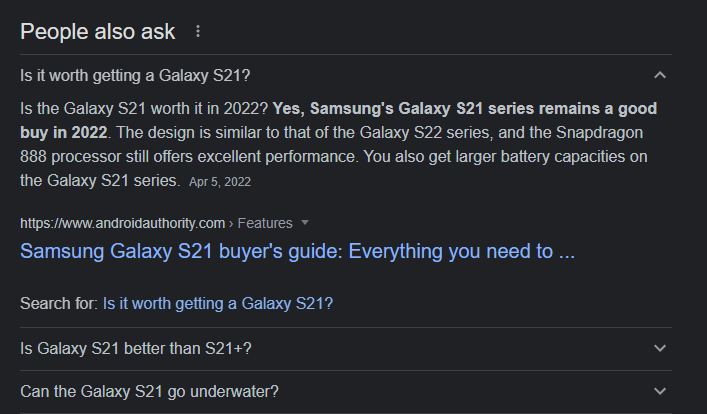
Do you want to fine-tune your search engine optimization (SEO) strategy and increase your organic traffic? If so, it’s time to consider the benefits of adding schema markup to your site. Schema markup helps Google learn more about your product or service, making it easier to show rich snippets when someone searches for one of your keywords or phrases.
If you’re asking yourself, “What are rich snippets, and how can they help me grow my business?” stick around. This article will answer the following questions:
- What is a rich snippet?
- Why should I use rich snippets for your online store?
- How can I add schema markup to my website?
What is a rich snippet?
A single Google search can bring back millions of websites. For example, the term Samsung Galaxy S21 returns around 212 million unique links. Most of these results, however, don’t give online shoppers the facts they need to make an informed decision.
On the other hand, rich snippets add additional value to search results and make them more user friendly. When you consider that 95% of people don’t make it past the first page of search results, it’s easy to see why this could be a valuable change for your small business.
Here are a few examples of regular snippets so you can see what we mean:

There’s not much information you can get from standard snippets. At most, you’ll see a title, a short meta description, and a URL to the website. For someone considering buying a Samsung Galaxy S21, this probably won’t be enough to justify a purchase.
Now, let’s compare this to a few rich snippet search results for the term Galaxy S21.

As you can see, these search results contain more relevant information for consumers. Shoppers can see reviews, pricing, feature availability, and more without leaving Google’s results when businesses have rich snippets.
Google pulls product rich snippets from structured data tucked into the HTML on your website.
So while the typical search results lack clarity, a rich snippet can provide a wealth of information to shoppers. If someone was thinking about buying this phone, seeing near-perfect reviews, a high number of verified customers, and a consistent price range could be the tipping point in their shopping experience.
Now that you have a better understanding of rich snippets, we’ll share five concrete reasons you should optimize critical parts of your website for product rich snippets.
Why should I use rich snippets for my online store?
1. Improve your organic reach
Experts at Google have explicitly said structured data does not directly correlate to a better position in the SERPS. However, they did admit engagement that comes as a result of structured data can determine your placement.
In other words, a boost in search results (and organic traffic) is a side effect of schema markup instead of a direct cause.
For example, say you’ve added structured data to your online clothing store. Now, visitors can see the price of a pair of boots before clicking over to your site. Additional information about your products doesn’t send a clear signal to Google that says they need to adjust the position of your site.
But suppose your site is getting 80% more clicks because visitors can see more information about your products. This would send positive signals to Google’s algorithm, which can potentially improve your ranking in the SERPs, leading to even more traffic.
The point is that it’s possible to gradually improve your organic reach by providing would-be customers with detailed information about your products or services through rich snippets.
2. Answer questions and overcome objections with FAQs
FAQ pages are an excellent way to answer common questions and overcome customer objections. Think about the last time you made a purchase online. There’s a good chance you thought of several reasons to hit the back button instead of proceeding with your order.
When customers feel this way on your site, you want to be there to address their concerns. Product FAQ pages can help you overcome user objections and drive more sales.
Adding structured data to your FAQ page could result in your answer appearing as a rich snippet within Google’s search results. Here’s an example:

The list of questions under ‘People also ask’ are pulled from rich snippets. If you click on one of the questions, here’s what happens:

The drop down reveals a portion of an answer and a link to the website that wrote the answer. But adding schema markup to your website isn’t enough to instantly get one of these spots. You have to optimize the speed and performance of your website, especially for mobile devices. It’s also vital to include the question and answer in-text on the page with the structured data.
Respond to the answer in a natural, conversational tone, and there’s a chance you can answer your potential buyer’s question before they even visit your eCommerce store. This type of helpful behavior usually leads to more visitors checking out your website and, hopefully, becoming customers.
3. Drive more voice search traffic
Speaking of conversational content, rich snippets can also help you drive more voice search traffic to your website.
Consumers use voice search on many of their favorite devices when they want to learn more about a brand or buy something online. Google understands this and prioritizes results in a unique way for smart speakers like Amazon’s Alexa and voice-powered tech like iPhone’s Siri.
A whopping 62% of people who own smart speakers say they’ve used their device to shop online, so you can safely assume that your target audience is out there looking for your product or service.
Research shows that this trend will continue in the coming years. In fact, it’s been projected that by the end of 2022, around 30% of all searches will occur without a screen.
The best way to get rich snippets to show up in voice search results is to publish plenty of concise, actionable content. Your blog is an excellent place to start. More than 70% of online shoppers prefer getting to know a business through their content instead of paid ads. If your website appears naturally in the voice search rich results, you will likely see increased traffic, sales, and engagement.
4. Show off eye-catching images and videos
When was the last time you bought something online before seeing it? My guess is it has been a very long time. Businesses and marketing teams know consumers want to see high-quality images and videos showing off a product before they even think about pulling out their card.
The obvious answer was to include pictures or video demonstrations on each product page. This strategy works well, but it’s no longer enough. If you want to maximize your reach, consider adding structured data to pictures and images on your product landing pages.
Structured data can boost how images appear on your search engine listing and Google Images. For example, here are the image results for Samsung Galaxy S21:

Do you see how some items have the price tag sticker? If you look towards the middle, you’ll even see an image that has a green ‘In stock’ icon. These extra features are a result of businesses adding schema markup on their product pages.
Here’s how an image will look if it’s included with the search result:

The simple option to see an item before opening a website can make a big difference in your traffic and conversion rate. This is just one more way to use product rich snippets for your online store.
5. Build trust with first-time visitors
One of the most important things you can do with rich snippets is build trust with your audience. Most people will not shop with a new company unless they see social proof. Social proof is evidence that your product or service met or exceeded the expectations of existing customers.
The most common form of social proof is user ratings and reviews. An impressive 83% of consumers say they trust verified reviews more than advertising.
In our first example, we showed you how the right structured data could help you show reviews and star ratings from Google. This feature is called a review snippet, and it’s something you should strive to show when a user finds one of your product pages.
Shoppers are far more likely to visit your site if they see that thousands of other people trust and respect your company. The exciting thing about this feature is you can apply it to more than physical products. You can also show reviews for:
- Digital books
- Events
- Recipes
- Software
- And much more
Adding product rich snippets schema to your store
Now that you can see the benefits of getting featured rich snippets let’s show you how to implement structured markup on your site.
If you’re interested in doing things manually, I suggest using Google’s Structured Data Markup Helper. This tool will help you build your schema data from the ground up. This method can be time-consuming, but it’s a great way to make sure things are in order on the backend of your website.
Once you create your schema markup data, add it to the HTML file of the page you want to have a featured snippet. You can do this by simply copying and pasting the code from the helper tool underneath the <HEAD> section of your file.
An easier way to add product rich snippets to your website is with a tool like All in One SEO (AIOSEO). AIOSEO comes with the tools you need to make schema markup for product pages, FAQs, and even pages designed for local SEO.
The best part about this process is you won’t have to touch a line of code. This intuitive WordPress SEO plugin will guide you through the process of getting your schema markup set up so you can take advantage of rich snippets.
Final Thoughts
Product rich snippets are the new normal for online businesses. If you want to improve your reach, increase sales, and skyrocket engagement, you have to make it easy for visitors to learn about your brand before they click on your website.
The benefits of obtaining snippets we mentioned today are just a few of many. Luckily, it’s never been easier to add product rich snippets to your online store.
Syed Balkhi is an award-winning entrepreneur and online marketing expert. He is the co-founder of OptinMonster, WPBeginner, MonsterInsights, and WPForms.







Comments ( 336 )
Justinraw
August 13, 2025
purple pharmacy mexico price list: Mexican Pharmacy Hub - Mexican Pharmacy Hub
Jamesket
August 13, 2025
Indian Meds One: Indian Meds One - top online pharmacy india
RoccoCoips
August 13, 2025
Mexican Pharmacy Hub: buy kamagra oral jelly mexico - Mexican Pharmacy Hub
Justinraw
August 12, 2025
mexico pharmacies prescription drugs: mexican pharmaceuticals online - buying from online mexican pharmacy
HoustonPox
August 12, 2025
Online medicine home delivery [url=https://indianmedsone.shop/#]indian pharmacy[/url] india pharmacy mail order
RoccoCoips
August 12, 2025
low cost mexico pharmacy online: Mexican Pharmacy Hub - buy propecia mexico
Jamesket
August 12, 2025
india pharmacy mail order: Indian Meds One - Indian Meds One
Justinraw
August 12, 2025
pharmacy store locator: MediDirect USA - MediDirect USA
RoccoCoips
August 12, 2025
MediDirect USA: legal online pharmacy review - generic cialis online pharmacy
HoustonPox
August 12, 2025
Mexican Pharmacy Hub [url=https://mexicanpharmacyhub.shop/#]buy viagra from mexican pharmacy[/url] Mexican Pharmacy Hub
Jamesket
August 12, 2025
Indian Meds One: best online pharmacy india - Indian Meds One
Justinraw
August 12, 2025
bradley pharmacy artane: MediDirect USA - can i get viagra from pharmacy
RoccoCoips
August 12, 2025
Mexican Pharmacy Hub: Mexican Pharmacy Hub - get viagra without prescription from mexico
Jamesket
August 12, 2025
indian pharmacy paypal: Indian Meds One - reputable indian pharmacies
HoustonPox
August 12, 2025
MediDirect USA [url=https://medidirectusa.shop/#]pharmacy dispensing clozaril[/url] MediDirect USA
Justinraw
August 12, 2025
Indian Meds One: Indian Meds One - india pharmacy mail order
RoccoCoips
August 12, 2025
Indian Meds One: indian pharmacy - indian pharmacies safe
Jamesket
August 12, 2025
Online medicine order: reputable indian online pharmacy - Indian Meds One
Larryres
August 11, 2025
Swerte99 login [url=https://swertewin.life/#]Swerte99[/url] Swerte99 casino walang deposit bonus para sa Pinoy
RobertSow
August 11, 2025
https://jilwin.pro/# Jiliko casino
1WIn
August 11, 2025
https://t.me/s/Officialnii_1win
DonaldChats
August 11, 2025
Jiliko casino walang deposit bonus para sa Pinoy: Jiliko slots - Jiliko casino
Larryres
August 10, 2025
Online gambling platform Jollibet [url=https://1winphili.company/#]Online betting Philippines[/url] Jollibet online sabong
RobertSow
August 10, 2025
https://jilwin.pro/# maglaro ng Jiliko online sa Pilipinas
ScottBrins
August 10, 2025
jilwin: Jiliko casino - Jiliko
Larryres
August 10, 2025
Swerte99 casino walang deposit bonus para sa Pinoy [url=https://swertewin.life/#]Swerte99 slots[/url] Swerte99
ScottBrins
August 10, 2025
GK88: Khuy?n mãi GK88 - Khuy?n mãi GK88
Larryres
August 10, 2025
Jiliko login [url=https://jilwin.pro/#]Jiliko app[/url] maglaro ng Jiliko online sa Pilipinas
Larryres
August 9, 2025
Slot gacor hari ini [url=https://mandiwinindo.site/#]Mandiribet[/url] Slot gacor hari ini
ScottBrins
August 9, 2025
Slot gacor Beta138: Situs judi resmi berlisensi - Bandar bola resmi
RodneySlubs
August 9, 2025
Abutogel: Bandar togel resmi Indonesia - Link alternatif Abutogel
DonaldChats
August 9, 2025
Jiliko login: Jiliko casino - Jiliko casino
Larryres
August 9, 2025
Abutogel [url=https://abutowin.icu/#]Link alternatif Abutogel[/url] Situs togel online terpercaya
RobertSow
August 9, 2025
https://pinwinaz.pro/# Slot oyunlar? Pinco-da
RodneySlubs
August 9, 2025
Bonus new member 100% Mandiribet: Slot gacor hari ini - Live casino Mandiribet
DonaldChats
August 9, 2025
Jiliko casino: Jiliko - Jiliko app
Larryres
August 8, 2025
Abutogel [url=https://abutowin.icu/#]Bandar togel resmi Indonesia[/url] Link alternatif Abutogel
DonaldChats
August 8, 2025
Slot game d?i thu?ng: Casino online GK88 - Tro choi n? hu GK88
RodneySlubs
August 8, 2025
Dang ky GK88: Dang ky GK88 - Khuy?n mai GK88
DonaldChats
August 8, 2025
Login Beta138: Slot gacor Beta138 - Link alternatif Beta138
Larryres
August 8, 2025
Swerte99 online gaming Pilipinas [url=https://swertewin.life/#]Swerte99 login[/url] Swerte99
RodneySlubs
August 8, 2025
Khuy?n mai GK88: Dang ky GK88 - Rut ti?n nhanh GK88
ScottBrins
August 8, 2025
Link alternatif Abutogel: Situs togel online terpercaya - Abutogel
DonaldChats
August 8, 2025
Link alternatif Beta138: Live casino Indonesia - Live casino Indonesia
JessieCof
August 7, 2025
ivermectin products: IverCare Pharmacy - IverCare Pharmacy
RaymondTiz
August 7, 2025
Zanaflex medication fast delivery: RelaxMeds USA - safe online source for Tizanidine
JefferyJar
August 7, 2025
https://glucosmartrx.shop/# rybelsus generic brand
JessieCof
August 7, 2025
lasix uses: lasix online - FluidCare Pharmacy
JessieCof
August 7, 2025
AsthmaFree Pharmacy: AsthmaFree Pharmacy - ventolin australia prescription
RaymondTiz
August 7, 2025
ventolin 2018: AsthmaFree Pharmacy - AsthmaFree Pharmacy
JessieCof
August 7, 2025
ventolin brand name: AsthmaFree Pharmacy - AsthmaFree Pharmacy
RaymondTiz
August 7, 2025
semaglutide to tirzepatide dose conversion: side effects of rybelsus 3 mg - hers semaglutide cost
JefferyJar
August 7, 2025
http://relaxmedsusa.com/# prescription-free muscle relaxants
Harrywar
August 7, 2025
order Tizanidine without prescription [url=https://relaxmedsusa.shop/#]Zanaflex medication fast delivery[/url] buy Zanaflex online USA
Harrywar
August 6, 2025
ivermectin half life [url=https://ivercarepharmacy.com/#]stromectol dose[/url] stromectol pills
Roberttah
August 6, 2025
AsthmaFree Pharmacy: is rybelsus the same as wegovy - AsthmaFree Pharmacy
RaymondTiz
August 6, 2025
affordable Zanaflex online pharmacy: order Tizanidine without prescription - safe online source for Tizanidine
JefferyJar
August 6, 2025
https://glucosmartrx.shop/# AsthmaFree Pharmacy
Roberttah
August 6, 2025
when is the best time to take semaglutide: how to inject semaglutide - rybelsus 3 mg for weight loss
RaymondTiz
August 6, 2025
ivermectin pour on for human lice: ivermectin treatment - IverCare Pharmacy
Conniefauct
August 5, 2025
More articles like this would make the blogosphere richer. https://ondactone.com/simvastatin/
Harrywar
August 5, 2025
FluidCare Pharmacy [url=https://fluidcarepharmacy.com/#]lasix for sale[/url] FluidCare Pharmacy
JessieCof
August 5, 2025
AsthmaFree Pharmacy: ventolin generic price - AsthmaFree Pharmacy
JefferyJar
August 5, 2025
https://relaxmedsusa.shop/# RelaxMeds USA
RaymondTiz
August 5, 2025
FluidCare Pharmacy: lasix 100 mg tablet - lasix for sale
JessieCof
August 5, 2025
Tizanidine tablets shipped to USA: RelaxMeds USA - cheap muscle relaxer online USA
Harrywar
August 5, 2025
fda rybelsus [url=https://glucosmartrx.com/#]AsthmaFree Pharmacy[/url] rybelsus for weight loss cost
RaymondTiz
August 4, 2025
lasix for sale: FluidCare Pharmacy - lasix generic name
JefferyJar
August 4, 2025
http://glucosmartrx.com/# AsthmaFree Pharmacy
JessieCof
August 4, 2025
AsthmaFree Pharmacy: AsthmaFree Pharmacy - online pharmacy ventolin
Harrywar
August 4, 2025
ivermectin injectable for humans [url=https://ivercarepharmacy.com/#]IverCare Pharmacy[/url] IverCare Pharmacy
JessieCof
August 4, 2025
buy Zanaflex online USA: Tizanidine tablets shipped to USA - RelaxMeds USA
JefferyJar
August 4, 2025
http://fluidcarepharmacy.com/# FluidCare Pharmacy
AntonioNeuff
August 4, 2025
FluidCare Pharmacy: lasix 20 mg - lasix online
Harrywar
August 3, 2025
furosemide 40mg [url=https://fluidcarepharmacy.shop/#]lasix furosemide[/url] FluidCare Pharmacy
AntonioNeuff
August 3, 2025
lasix 100 mg: FluidCare Pharmacy - lasix 40mg
Harrywar
August 3, 2025
IverCare Pharmacy [url=https://ivercarepharmacy.com/#]IverCare Pharmacy[/url] ivermectin goodrx
JefferyJar
August 3, 2025
http://glucosmartrx.com/# generic rybelsus cost
AntonioNeuff
August 3, 2025
AsthmaFree Pharmacy: generic ventolin price - ventolin tabs 4mg
Harrywar
August 3, 2025
lasix 40mg [url=https://fluidcarepharmacy.com/#]FluidCare Pharmacy[/url] FluidCare Pharmacy
AntonioNeuff
August 3, 2025
lasix uses: furosemide 100 mg - FluidCare Pharmacy
RichardSpems
August 3, 2025
buy prescription drugs from india: IndiGenix Pharmacy - IndiGenix Pharmacy
RichardAcivy
August 3, 2025
buy medicines online in india: IndiGenix Pharmacy - IndiGenix Pharmacy
Jamesslema
August 2, 2025
MexiCare Rx Hub [url=https://mexicarerxhub.com/#]buy antibiotics over the counter in mexico[/url] sildenafil mexico online
RichardSpems
August 2, 2025
vipps canadian pharmacy: vipps approved canadian online pharmacy - CanadRx Nexus
RichardAcivy
August 2, 2025
india pharmacy: indian pharmacy paypal - buy prescription drugs from india
Jamesslema
August 2, 2025
CanadRx Nexus [url=https://canadrxnexus.shop/#]canadian pharmacy india[/url] best canadian pharmacy online
Samueljiday
August 2, 2025
MexiCare Rx Hub: MexiCare Rx Hub - buy viagra from mexican pharmacy
Jamesslema
August 1, 2025
MexiCare Rx Hub [url=https://mexicarerxhub.shop/#]MexiCare Rx Hub[/url] best prices on finasteride in mexico
Samueljiday
August 1, 2025
MexiCare Rx Hub: MexiCare Rx Hub - amoxicillin mexico online pharmacy
RichardAcivy
August 1, 2025
india pharmacy: world pharmacy india - mail order pharmacy india
JessePoels
August 1, 2025
https://mexicarerxhub.shop/# mexico drug stores pharmacies
Jamesslema
August 1, 2025
top online pharmacy india [url=https://indigenixpharm.com/#]world pharmacy india[/url] Online medicine order
RichardAcivy
August 1, 2025
mexico drug stores pharmacies: MexiCare Rx Hub - purple pharmacy mexico price list
Jamesslema
August 1, 2025
prescription drugs mexico pharmacy [url=http://mexicarerxhub.com/#]buy cialis from mexico[/url] accutane mexico buy online
RichardSpems
August 1, 2025
canadian pharmacy 24h com safe: CanadRx Nexus - canadian pharmacy service
RichardAcivy
August 1, 2025
CanadRx Nexus: CanadRx Nexus - canadian discount pharmacy
Jamesslema
August 1, 2025
mail order pharmacy india [url=http://indigenixpharm.com/#]top 10 online pharmacy in india[/url] online shopping pharmacy india
RichardAcivy
July 31, 2025
CanadRx Nexus: best canadian pharmacy online - canadian valley pharmacy
Jamesslema
July 31, 2025
top 10 online pharmacy in india [url=https://indigenixpharm.com/#]cheapest online pharmacy india[/url] IndiGenix Pharmacy
Samueljiday
July 31, 2025
indian pharmacy online: IndiGenix Pharmacy - buy prescription drugs from india
Jamesslema
July 31, 2025
MexiCare Rx Hub [url=https://mexicarerxhub.shop/#]low cost mexico pharmacy online[/url] generic drugs mexican pharmacy
RichardSpems
July 31, 2025
п»їmexican pharmacy: order kamagra from mexican pharmacy - MexiCare Rx Hub
Samueljiday
July 31, 2025
india online pharmacy: IndiGenix Pharmacy - buy medicines online in india
Jamesslema
July 31, 2025
IndiGenix Pharmacy [url=https://indigenixpharm.shop/#]indian pharmacy online[/url] IndiGenix Pharmacy
Jamesslema
July 31, 2025
tadalafil mexico pharmacy [url=http://mexicarerxhub.com/#]gabapentin mexican pharmacy[/url] viagra pills from mexico
RichardAcivy
July 31, 2025
pharmacies in mexico that ship to usa: mexico drug stores pharmacies - MexiCare Rx Hub
RichardSpems
July 31, 2025
buy cheap meds from a mexican pharmacy: MexiCare Rx Hub - MexiCare Rx Hub
JessePoels
July 31, 2025
https://indigenixpharm.shop/# IndiGenix Pharmacy
Jamesslema
July 30, 2025
best online pharmacy india [url=http://indigenixpharm.com/#]IndiGenix Pharmacy[/url] IndiGenix Pharmacy
RichardAcivy
July 30, 2025
CanadRx Nexus: reliable canadian pharmacy reviews - canada rx pharmacy world
Larrywek
July 30, 2025
iv prednisone: cheap prednisone online - over the counter prednisone cheap
Jamesicorm
July 30, 2025
NeuroRelief Rx [url=http://neuroreliefrx.com/#]NeuroRelief Rx[/url] equine gabapentin dose
RalphKet
July 30, 2025
Clomid Hub: can i get clomid no prescription - buy generic clomid pill
BrianLit
July 30, 2025
where can i buy amoxicillin over the counter: order amoxicillin without prescription - low-cost antibiotics delivered in USA
PatrickGar
July 30, 2025
https://clomidhubpharmacy.com/# Clomid Hub
Larrywek
July 30, 2025
Relief Meds USA: Relief Meds USA - ReliefMeds USA
Jamesicorm
July 30, 2025
can you buy fluoxetine [url=https://neuroreliefrx.shop/#]NeuroRelief Rx[/url] gabapentin purpura
RalphKet
July 30, 2025
where can i buy clomid no prescription: where buy clomid for sale - clomid medication
BrianLit
July 30, 2025
buy amoxicillin 500mg usa: buy amoxicillin 500mg uk - rexall pharmacy amoxicillin 500mg
Larrywek
July 29, 2025
ReliefMeds USA: prednisone in uk - Relief Meds USA
Jamesicorm
July 29, 2025
low-cost antibiotics delivered in USA [url=https://clearmedsdirect.shop/#]Clear Meds Direct[/url] ClearMeds Direct
BrianLit
July 29, 2025
prednisone 10: Relief Meds USA - order corticosteroids without prescription
PatrickGar
July 29, 2025
http://wakemedsrx.com/# WakeMedsRX
Larrywek
July 29, 2025
ReliefMeds USA: ReliefMeds USA - prednisone online india
Jamesicorm
July 29, 2025
buy Modafinil online USA [url=https://wakemedsrx.shop/#]Modafinil for ADHD and narcolepsy[/url] Wake Meds RX
RalphKet
July 29, 2025
Clomid Hub: Clomid Hub Pharmacy - Clomid Hub
BrianLit
July 29, 2025
gabapentin 300mg: gabapentin 600 mg two at night - where can i buy gabapentin
Jamesicorm
July 29, 2025
prednisone 30 [url=https://reliefmedsusa.com/#]anti-inflammatory steroids online[/url] order corticosteroids without prescription
Larrywek
July 29, 2025
where can i buy prednisone without prescription: anti-inflammatory steroids online - pharmacy cost of prednisone
RalphKet
July 29, 2025
Modafinil for ADHD and narcolepsy: Wake Meds RX - prescription-free Modafinil alternatives
BrianLit
July 29, 2025
affordable Modafinil for cognitive enhancement: wakefulness medication online no Rx - where to buy Modafinil legally in the US
PatrickGar
July 29, 2025
https://neuroreliefrx.com/# NeuroRelief Rx
Jamesicorm
July 28, 2025
clomid cheap [url=https://clomidhubpharmacy.com/#]Clomid Hub[/url] where can i get cheap clomid without insurance
RalphKet
July 28, 2025
Clear Meds Direct: low-cost antibiotics delivered in USA - ClearMeds Direct
Larrywek
July 28, 2025
prednisone buy no prescription: ReliefMeds USA - order corticosteroids without prescription
BrianLit
July 28, 2025
ClearMeds Direct: ClearMeds Direct - low-cost antibiotics delivered in USA
RalphKet
July 28, 2025
antibiotic treatment online no Rx: order amoxicillin without prescription - low-cost antibiotics delivered in USA
Jamesicorm
July 28, 2025
smart drugs online US pharmacy [url=https://wakemedsrx.shop/#]WakeMeds RX[/url] where to buy Modafinil legally in the US
BrianLit
July 28, 2025
buy generic fluoxetine: does gabapentin increase your blood pressure - NeuroRelief Rx
PatrickGar
July 28, 2025
https://reliefmedsusa.shop/# order corticosteroids without prescription
RalphKet
July 28, 2025
order corticosteroids without prescription: prednisone buy without prescription - Relief Meds USA
Jamesicorm
July 28, 2025
ClearMeds Direct [url=http://clearmedsdirect.com/#]ClearMeds Direct[/url] ClearMeds Direct
BrianLit
July 28, 2025
can i order generic clomid tablets: order clomid price - Clomid Hub
Larrywek
July 28, 2025
anti-inflammatory steroids online: anti-inflammatory steroids online - ReliefMeds USA
RalphKet
July 28, 2025
order amoxicillin without prescription: antibiotic treatment online no Rx - ClearMeds Direct
BrianLit
July 28, 2025
NeuroRelief Rx: how long until gabapentin is out of your system - gabapentin pics
Jamesicorm
July 28, 2025
NeuroRelief Rx [url=http://neuroreliefrx.com/#]ip 102 yellow capsule gabapentin[/url] can you get high off gabapentin 100mg
Jamesicorm
July 27, 2025
where to buy generic clomid pill [url=https://clomidhubpharmacy.shop/#]Clomid Hub Pharmacy[/url] buying clomid for sale
BrianLit
July 27, 2025
Relief Meds USA: anti-inflammatory steroids online - order corticosteroids without prescription
PatrickGar
July 27, 2025
http://reliefmedsusa.com/# prednisone 4mg
Larrywek
July 27, 2025
Relief Meds USA: ReliefMeds USA - Relief Meds USA
RalphKet
July 27, 2025
amitriptyline baclofen gabapentin gel: NeuroRelief Rx - NeuroRelief Rx
Jamesicorm
July 27, 2025
anti-inflammatory steroids online [url=http://reliefmedsusa.com/#]prednisone 10mg tablets[/url] ReliefMeds USA
BrianLit
July 27, 2025
order corticosteroids without prescription: Relief Meds USA - 20 mg of prednisone
PatrickGar
July 27, 2025
http://reliefmedsusa.com/# online order prednisone 10mg
Larrywek
July 27, 2025
buying prednisone on line: ReliefMeds USA - 10mg prednisone daily
BrianLit
July 27, 2025
ClearMeds Direct: buy amoxicillin 500mg - low-cost antibiotics delivered in USA
Jamesicorm
July 26, 2025
NeuroRelief Rx [url=https://neuroreliefrx.shop/#]NeuroRelief Rx[/url] gabapentin lower extremity edema
Larrywek
July 26, 2025
Relief Meds USA: order corticosteroids without prescription - order corticosteroids without prescription
BrianLit
July 26, 2025
ReliefMeds USA: Relief Meds USA - order corticosteroids without prescription
TommyRof
July 26, 2025
http://finasteridefromcanada.com/# generic Finasteride without prescription
LeroyCrelp
July 26, 2025
Finasteride From Canada: generic Finasteride without prescription - Propecia for hair loss online
LeroyCrelp
July 26, 2025
USA-safe Accutane sourcing: cheap Accutane - generic isotretinoin
LeroyCrelp
July 26, 2025
buy Zoloft online: purchase generic Zoloft online discreetly - generic sertraline
KelvinCaniA
July 25, 2025
order isotretinoin from Canada to US: generic isotretinoin - generic isotretinoin
LeroyCrelp
July 25, 2025
tadalafil online no rx: tadalafil online no rx - Cialis without prescription
BurtonAbseD
July 25, 2025
cheap Propecia Canada [url=https://finasteridefromcanada.com/#]get propecia no prescription[/url] Finasteride From Canada
TommyRof
July 25, 2025
https://finasteridefromcanada.shop/# cost of propecia without dr prescription
KelvinCaniA
July 25, 2025
sertraline online: buy Zoloft online without prescription USA - purchase generic Zoloft online discreetly
LeroyCrelp
July 25, 2025
cheap Cialis Canada: buy Cialis online cheap - Tadalafil From India
BurtonAbseD
July 25, 2025
Zoloft Company [url=https://zoloft.company/#]generic sertraline[/url] Zoloft for sale
KelvinCaniA
July 25, 2025
Lexapro for depression online: lexapro 1.25 mg - Lexapro for depression online
LeroyCrelp
July 25, 2025
buy Zoloft online: cheap Zoloft - purchase generic Zoloft online discreetly
BurtonAbseD
July 25, 2025
generic lexapro australia [url=https://lexapro.pro/#]buy lexapro[/url] buy lexapro without a prescription online
LeroyCrelp
July 24, 2025
Lexapro for depression online: Lexapro for depression online - lexapro 20mg pill
Theronpow
July 24, 2025
https://finasteridefromcanada.shop/# Finasteride From Canada
TommyRof
July 24, 2025
https://zoloft.company/# generic sertraline
BurtonAbseD
July 24, 2025
USA-safe Accutane sourcing [url=https://isotretinoinfromcanada.shop/#]order isotretinoin from Canada to US[/url] isotretinoin online
p36th
July 24, 2025
Palatable blog you procure here.. It’s hard to assign high status writing like yours these days. I justifiably respect individuals like you! Withstand care!! equivalent viagra pour homme sans ordonnance
Theronpow
July 24, 2025
https://zoloft.company/# Zoloft Company
LeroyCrelp
July 24, 2025
buy Zoloft online: buy Zoloft online - sertraline online
BurtonAbseD
July 24, 2025
Lexapro for depression online [url=https://lexapro.pro/#]Lexapro for depression online[/url] lexapro cost australia
KelvinCaniA
July 24, 2025
п»їlexapro: Lexapro for depression online - where to buy generic lexapro
Theronpow
July 24, 2025
https://zoloft.company/# purchase generic Zoloft online discreetly
LeroyCrelp
July 24, 2025
Cialis without prescription: Tadalafil From India - purchase tadalafil online
BurtonAbseD
July 24, 2025
Propecia for hair loss online [url=https://finasteridefromcanada.shop/#]Finasteride From Canada[/url] Finasteride From Canada
TommyRof
July 24, 2025
https://lexapro.pro/# Lexapro for depression online
Theronpow
July 23, 2025
https://lexapro.pro/# Lexapro for depression online
LeroyCrelp
July 23, 2025
Zoloft online pharmacy USA: Zoloft for sale - cheap Zoloft
BurtonAbseD
July 23, 2025
best pharmacy buy tadalafil [url=http://tadalafilfromindia.com/#]buy Cialis online cheap[/url] generic Cialis from India
KelvinCaniA
July 23, 2025
tadalafil online no rx: generic Cialis from India - generic Cialis from India
Theronpow
July 23, 2025
http://finasteridefromcanada.com/# Propecia for hair loss online
LeroyCrelp
July 23, 2025
Zoloft online pharmacy USA: buy Zoloft online without prescription USA - Zoloft Company
BurtonAbseD
July 23, 2025
purchase generic Accutane online discreetly [url=http://isotretinoinfromcanada.com/#]isotretinoin online[/url] Isotretinoin From Canada
TommyRof
July 23, 2025
https://isotretinoinfromcanada.com/# cheap Accutane
KelvinCaniA
July 23, 2025
isotretinoin online: buy Accutane online - order isotretinoin from Canada to US
Theronpow
July 23, 2025
https://tadalafilfromindia.com/# generic Cialis from India
LeroyCrelp
July 23, 2025
Lexapro for depression online: Lexapro for depression online - lexapro 20
BurtonAbseD
July 23, 2025
buy Accutane online [url=https://isotretinoinfromcanada.com/#]purchase generic Accutane online discreetly[/url] generic isotretinoin
Theronpow
July 22, 2025
https://tadalafilfromindia.shop/# Cialis without prescription
KelvinCaniA
July 22, 2025
isotretinoin online: order isotretinoin from Canada to US - buy Accutane online
LeroyCrelp
July 22, 2025
lexapro 20mg: how much is lexapro in australia - Lexapro for depression online
BurtonAbseD
July 22, 2025
get generic propecia without rx [url=https://finasteridefromcanada.com/#]cheap propecia without prescription[/url] buying cheap propecia
Theronpow
July 22, 2025
https://tadalafilfromindia.shop/# Cialis without prescription
TommyRof
July 22, 2025
http://tadalafilfromindia.com/# Tadalafil From India
KelvinCaniA
July 22, 2025
Tadalafil From India: buy Cialis online cheap - cheap Cialis Canada
LeroyCrelp
July 22, 2025
Isotretinoin From Canada: buy Accutane online - isotretinoin online
BurtonAbseD
July 22, 2025
Isotretinoin From Canada [url=https://isotretinoinfromcanada.shop/#]isotretinoin online[/url] cheap Accutane
Theronpow
July 22, 2025
https://isotretinoinfromcanada.shop/# isotretinoin online
KelvinCaniA
July 22, 2025
buy cheap propecia: Finasteride From Canada - Finasteride From Canada
LeroyCrelp
July 22, 2025
Cialis without prescription: tadalafil online no rx - generic Cialis from India
hq4cz
July 22, 2025
Thanks for putting this up. It’s evidently done. https://prohnrg.com/product/atenolol-50-mg-online/
Theronpow
July 22, 2025
https://lexapro.pro/# lexapro escitalopram
BurtonAbseD
July 22, 2025
buy Zoloft online without prescription USA [url=https://zoloft.company/#]cheap Zoloft[/url] Zoloft for sale
TommyRof
July 21, 2025
https://tadalafilfromindia.shop/# Cialis without prescription
KelvinCaniA
July 21, 2025
Lexapro for depression online: Lexapro for depression online - lexapro generic discount
LeroyCrelp
July 21, 2025
Zoloft online pharmacy USA: purchase generic Zoloft online discreetly - Zoloft online pharmacy USA
Theronpow
July 21, 2025
https://zoloft.company/# Zoloft Company
BurtonAbseD
July 21, 2025
cheap Zoloft [url=https://zoloft.company/#]generic sertraline[/url] sertraline online
KelvinCaniA
July 21, 2025
buy Zoloft online: purchase generic Zoloft online discreetly - sertraline online
LeroyCrelp
July 21, 2025
buy Zoloft online without prescription USA: buy Zoloft online - Zoloft Company
Theronpow
July 21, 2025
https://zoloft.company/# buy Zoloft online
TommyRof
July 21, 2025
http://finasteridefromcanada.com/# buy propecia price
BurtonAbseD
July 21, 2025
cheap Propecia Canada [url=https://finasteridefromcanada.shop/#]cheap Propecia Canada[/url] Propecia for hair loss online
LeroyCrelp
July 21, 2025
generic Cialis from India: cheap Cialis Canada - Cialis without prescription
KelvinCaniA
July 21, 2025
generic isotretinoin: generic isotretinoin - Isotretinoin From Canada
Theronpow
July 21, 2025
https://zoloft.company/# buy Zoloft online
BurtonAbseD
July 21, 2025
Finasteride From Canada [url=https://finasteridefromcanada.shop/#]cost of propecia without insurance[/url] Propecia for hair loss online
KelvinCaniA
July 21, 2025
buy Cialis online cheap: cheap Cialis Canada - Cialis without prescription
Theronpow
July 21, 2025
http://isotretinoinfromcanada.com/# cheap Accutane
Davidzetry
July 20, 2025
online cialis pharmacy reviews [url=http://expresscarerx.org/#]online pharmacy furosemide[/url] ExpressCareRx
Bobbymew
July 20, 2025
online pharmacy usa: ExpressCareRx - ExpressCareRx
Conniefauct
July 20, 2025
Thanks an eye to sharing. It’s top quality. https://ursxdol.com/doxycycline-antibiotic/
Robertvok
July 20, 2025
https://expresscarerx.online/# ExpressCareRx
VernonVig
July 20, 2025
http://medimexicorx.com/# medicine in mexico pharmacies
Davidzetry
July 20, 2025
Tadacip [url=https://expresscarerx.online/#]best us online pharmacy[/url] rite aid pharmacy viagra prices
Robertvok
July 20, 2025
https://medimexicorx.shop/# best mexican online pharmacies
Bobbymew
July 20, 2025
IndiaMedsHub: india online pharmacy - IndiaMedsHub
Davidzetry
July 20, 2025
tamiflu pharmacy [url=http://expresscarerx.org/#]ExpressCareRx[/url] ExpressCareRx
Robertvok
July 20, 2025
https://expresscarerx.org/# ExpressCareRx
Bobbymew
July 20, 2025
MediMexicoRx: real mexican pharmacy USA shipping - MediMexicoRx
VernonVig
July 19, 2025
https://indiamedshub.com/# reputable indian pharmacies
Robertvok
July 19, 2025
https://indiamedshub.shop/# buy prescription drugs from india
Davidzetry
July 19, 2025
Lexapro [url=https://expresscarerx.online/#]ExpressCareRx[/url] rx plus pharmacy nyc
Bobbymew
July 19, 2025
online pharmacy without insurance: bupropion hcl xl global pharmacy - online mail order pharmacy
Robertvok
July 19, 2025
https://indiamedshub.shop/# best india pharmacy
LewisTes
July 19, 2025
accutane mexico buy online: isotretinoin from mexico - best prices on finasteride in mexico
Davidzetry
July 19, 2025
ed pills online [url=https://expresscarerx.org/#]ExpressCareRx[/url] online pharmacy no prescription needed klonopin
Bobbymew
July 19, 2025
semaglutide mexico price: mexico pharmacy - legit mexican pharmacy without prescription
rphpn
July 19, 2025
More peace pieces like this would make the web better. purchase zithromax
VernonVig
July 19, 2025
https://medimexicorx.shop/# mexican drugstore online
Robertvok
July 19, 2025
https://indiamedshub.shop/# IndiaMedsHub
Davidzetry
July 19, 2025
order kamagra from mexican pharmacy [url=https://medimexicorx.com/#]MediMexicoRx[/url] cheap mexican pharmacy
Bobbymew
July 19, 2025
online pharmacy cheap viagra: mexican pharmacy online medications - discount pharmacy card
Robertvok
July 19, 2025
https://expresscarerx.org/# mutual of omaha rx pharmacy
Davidzetry
July 18, 2025
finpecia online pharmacy [url=http://expresscarerx.org/#]revia online pharmacy[/url] pharmacy websites
Bobbymew
July 18, 2025
proventil online pharmacy: ExpressCareRx - managing warfarin therapy in various pharmacy settings
Robertvok
July 18, 2025
https://indiamedshub.shop/# legitimate online pharmacies india
LewisTes
July 18, 2025
best online pharmacy india: IndiaMedsHub - buy prescription drugs from india
VernonVig
July 18, 2025
https://expresscarerx.org/# can buy viagra singapore pharmacy
Davidzetry
July 18, 2025
finasteride mexico pharmacy [url=http://medimexicorx.com/#]MediMexicoRx[/url] trusted mexico pharmacy with US shipping
Bobbymew
July 18, 2025
MediMexicoRx: accutane mexico buy online - MediMexicoRx
Robertvok
July 18, 2025
https://expresscarerx.org/# vermox online pharmacy
Conniefauct
July 18, 2025
This is a topic which is in to my verve… Many thanks! Unerringly where can I upon the acquaintance details in the course of questions? buy nolvadex sale
Davidzetry
July 18, 2025
price chopper pharmacy [url=https://expresscarerx.online/#]us pharmacy viagra no prescription[/url] best online pharmacy no prescription cialis
Bobbymew
July 18, 2025
MediMexicoRx: legit mexico pharmacy shipping to USA - MediMexicoRx
Robertvok
July 18, 2025
http://expresscarerx.org/# lexapro pharmacy prices
VernonVig
July 18, 2025
http://expresscarerx.org/# ExpressCareRx
LewisTes
July 18, 2025
MediMexicoRx: trusted mexico pharmacy with US shipping - finasteride mexico pharmacy
Bobbymew
July 18, 2025
top online pharmacy india: Online medicine order - indian pharmacy paypal
ScottVop
July 18, 2025
röd förhud barn [url=https://snabbapoteket.shop/#]svenska apotek[/url] snabba billiga recept
MichaelSmist
July 18, 2025
https://tryggmed.shop/# fjerne sting apotek
Altonloony
July 17, 2025
pregnancy test kit apotek: paracetamol tablet - antigentest apotek
KennethSpota
July 17, 2025
bestille reseptbelagt medisin pГҐ nett: Trygg Med - tungeskrape apotek
MichaelSmist
July 17, 2025
https://snabbapoteket.com/# apotek barn
ScottVop
July 17, 2025
medicatie bestellen online [url=http://zorgpakket.com/#]Medicijn Punt[/url] verzorgingsproducten apotheek
WilliamLiz
July 17, 2025
https://snabbapoteket.com/# duschskydd barn huvud
Altonloony
July 17, 2025
kolla blodtryck apotek: apotek nummer - apotek beställa hem
MichaelSmist
July 17, 2025
https://zorgpakket.com/# de apotheker
ScottVop
July 17, 2025
protein brun utan sol tabletter recension [url=https://snabbapoteket.shop/#]göra egen saltvattenspray[/url] apotek finland leverans sverige
pd5ry
July 17, 2025
order viagra india online - 50mg generic viagra buy viagra online cheap
Altonloony
July 17, 2025
apotek hudvård: destillerat vatten köpa apotek - skillnad bb och cc cream
KennethSpota
July 17, 2025
läkemedel recept: SnabbApoteket - kalcium mat lista
ScottVop
July 17, 2025
billig dricka [url=https://snabbapoteket.shop/#]svensk apotek[/url] var kan jag köpa
Altonloony
July 16, 2025
bilig: Trygg Med - rosmarin olje apotek
WilliamLiz
July 16, 2025
https://tryggmed.shop/# peppermynteolje apotek
MichaelSmist
July 16, 2025
https://zorgpakket.shop/# netherlands pharmacy online
KennethSpota
July 16, 2025
beställa medicin hem: Snabb Apoteket - ashwagandha tabletter
ScottVop
July 16, 2025
bestellen medicijnen [url=https://zorgpakket.shop/#]MedicijnPunt[/url] apotheek online nl
Altonloony
July 16, 2025
solariumsbriller apotek: engangshansker apotek - magnesium spray erfaringer
MichaelSmist
July 16, 2025
http://snabbapoteket.com/# vitamin a tabletter
KennethSpota
July 16, 2025
mijn medicijnkosten: apteka internetowa holandia - online pharmacy nl
ScottVop
July 16, 2025
helgeГҐpent apotek [url=http://tryggmed.com/#]vaksine apotek influensa[/url] flex apotek
Altonloony
July 16, 2025
schampo mot svamp på kroppen: förstoringsglas apotek - cbd olja apotek
MichaelSmist
July 16, 2025
http://zorgpakket.com/# online recept
KennethSpota
July 16, 2025
apteka online holandia: MedicijnPunt - online apotheek 24
ScottVop
July 16, 2025
isopropyl alcohol apotek [url=https://snabbapoteket.com/#]online apotek europa[/url] bröstpump apotek
Conniefauct
July 15, 2025
buy ranitidine sale - ranitidine over the counter buy zantac 150mg for sale
EdgarFelve
July 15, 2025
fosfomycine sans ordonnance: PharmaDirecte - douane mГ©dicament sans ordonnance
o1pv2
July 15, 2025
buy cialis online usa - where can i buy cialis on line buy cialis online overnight delivery
bz76i
July 13, 2025
cialis professional review - fast ciltad cheap generic cialis
qwqa1
July 11, 2025
buy generic cenforce 50mg - cenforce 100mg over the counter order cenforce 100mg pill
izqii
July 10, 2025
diflucan 100mg for sale - https://gpdifluca.com/ cost diflucan
b0hxr
July 6, 2025
buy amoxil pills for sale - combamoxi amoxil order online
sativa tincture
June 25, 2025
I’ve been using sativa tincture constantly on account of all about a month for the time being, and I’m indeed impressed before the positive effects. They’ve helped me perceive calmer, more balanced, and less restless from the beginning to the end of the day. My saw wood is deeper, I wake up refreshed, and uniform my focus has improved. The value is excellent, and I cherish the common ingredients. I’ll categorically keep buying and recommending them to the whole world I know!
lead nurturing
June 18, 2025
Thank you for the good writeup. It in fact was a amusement account it. Look advanced to more added agreeable from you! By the way, how can we communicate?
https://www.magileads.com/en/lead-nurturing/
mood cannabis
June 13, 2025
I recently tried mood cannabis , and I’m really impressed with the quality. The effects were smooth, calming, and exactly what I was hoping for. The variety of options also allowed me to detect something made-to-order in the direction of both relaxing evenings and rich days. Absolutely recommend for anyone seeking inordinate results!
ErnestHoody
June 12, 2025
I recently tried https://killakush.com/collections/thca-flower , and I’m in actuality impressed with the quality. The effects were serene, calming, and scrupulously what I was hoping for. The miscellany of options also allowed me to upon something flawless an eye to both relaxing evenings and fecund days. Indubitably advise proper for anyone seeking great results!
PatrickPoono
June 12, 2025
https://semaglupharm.com/# SemagluPharm
ErnestHoody
June 11, 2025
I recently tried https://killakush.com/products/focus-gummies , and I’m extraordinarily impressed with the quality. The effects were slick, calming, and literally what I was hoping for. The contrast of options also allowed me to upon something skilful for both relaxing evenings and bountiful days. Definitely recommend in favour of anyone seeking inordinate results!
WarrenChaig
June 10, 2025
I recently tried [url=https://killakush.com/collections/thca-flower ]thca exotic flower[/url] , and I’m in actuality impressed with the quality. The effects were serene, calming, and exactly what I was hoping for. The variety of options also allowed me to upon something perfect for both relaxing evenings and rich days. Indubitably commend proper for anyone seeking great results!
AaronQuelo
June 6, 2025
new zealand pharmacy motilium: discount online pharmacy - envision rx specialty pharmacy
Jamesaliem
May 31, 2025
achat kamagra: acheter kamagra site fiable - livraison discrète Kamagra
DanielTem
May 28, 2025
https://biotpharm.com/# cheapest antibiotics
* * * Get Free Bitcoin Now: https://www.motorolapromocionesmm.com/index.php?3eoz8w * * * hs=76ef000fd4c4523e6bc600238ae05ac8* ххх*
May 27, 2025
5sejzv
FloydDwema
May 26, 2025
I’ve been using https://www.nothingbuthemp.net/collections/mushroom-tinctures daily for on the other side of a month nowadays, and I’m indubitably impressed before the uncontested effects. They’ve helped me determine calmer, more balanced, and less anxious in every nook the day. My forty winks is deeper, I wake up refreshed, and straight my core has improved. The value is famous, and I worth the sensible ingredients. I’ll categorically carry on buying and recommending them to everyone I know!
FloydDwema
May 23, 2025
I’ve been using https://www.nothingbuthemp.net/products/sativa-gummies constantly in regard to over a month nowadays, and I’m indubitably impressed by the uncontested effects. They’ve helped me determine calmer, more balanced, and less anxious throughout the day. My forty winks is deeper, I wake up refreshed, and even my pinpoint has improved. The trait is distinguished, and I cognizant the common ingredients. I’ll definitely carry on buying and recommending them to everybody I identify!
DannyKag
May 18, 2025
I’ve been using [url=https://www.nothingbuthemp.net/collections/mushroom-drinks ]mushroom seltzers[/url] daily in regard to during the course of a month for the time being, and I’m indeed impressed at near the absolute effects. They’ve helped me determine calmer, more balanced, and less tense throughout the day. My saw wood is deeper, I wake up refreshed, and even my nave has improved. The value is outstanding, and I cognizant the common ingredients. I’ll definitely heed buying and recommending them to everybody I recall!
pHqghUme
May 4, 2025
1
🗝 + 1.659035 BTC.GET - https://graph.org/Official-donates-from-Binance-04-01?hs=76ef000fd4c4523e6bc600238ae05ac8& 🗝
April 16, 2025
20h4wc
📎 + 1.875552 BTC.GET - https://graph.org/Message--17856-03-25?hs=76ef000fd4c4523e6bc600238ae05ac8& 📎
April 15, 2025
6uw2kj
ElliottdreSk
March 29, 2025
https://dissertation-now.com/term-paper/
最佳Binance推荐代码
March 27, 2025
I don't think the title of your article matches the content lol. Just kidding, mainly because I had some doubts after reading the article.
binance register
March 23, 2025
Thank you for your sharing. I am worried that I lack creative ideas. It is your article that makes me full of hope. Thank you. But, I have a question, can you help me? https://accounts.binance.com/es/register?ref=T7KCZASX
sativa vape
March 17, 2025
I've recently started using sativa vape , and they’ve exceeded my expectations. From Delta 8 products to HHC products, the benefits are undeniable. They help reduce lay stress, recondition slumber, and unvaried ease slight aches. What I weakness most is that they’re standard and don’t commit me intuition groggy or out of it. The rank of hemp products makes a prodigious contrast, so I always look for trusted brands. Whether you’re brand-new to hemp or savvy, these products are a game-changer in the service of whole wellness.
EdwardDiath
March 17, 2025
I've recently started using https://elevateright.com/product/delta-8-thc-vape-pen-pineapple-express/ , and they’ve exceeded my expectations. From Delta 8 products to HHC products, the benefits are undeniable. They boost break down urgency, recondition catnap, and despite that smooth prosperity slight aches. What I enjoyment most is that they’re standard and don’t leave me feeling weak or out of it. The rank of hemp products makes a monumental difference, so I unceasingly look benefit of trusted brands. Whether you’re new to hemp or au fait, these products are a game-changer in the service of inclusive wellness.
sanal sunucu kiralama
March 15, 2025
sanal sunucu kiralama hizmetleri hakkında daha fazla bilgi almak için tıklayın.
EdwardDiath
March 14, 2025
I've recently started using https://elevateright.com/product/grape-soda-delta-8-disposable-vape/ , and they’ve exceeded my expectations. From Delta 8 products to HHC products, the benefits are undeniable. They forbear modify urgency, improve sleep, and unvaried expedite slight aches. What I weakness most is that they’re spontaneous and don’t remain me feeling groggy or elsewhere of it. The quality of hemp products makes a huge difference, so I forever look in the course of trusted brands. Whether you’re restored to hemp or experienced, these products are a game-changer pro inclusive wellness.
Robertslity
March 13, 2025
I've recently started using [url=https://elevateright.com/delta-8-gummies/ ]buy delta 8 gummies[/url] , and they’ve exceeded my expectations. From Delta 8 products to HHC products, the benefits are undeniable. They boost break down lay stress, fix up sleep, and unvaried opulence minor aches. What I love most is that they’re standard and don’t leave me intuition weak or absent from of it. The value of hemp products makes a tremendous contrast, so I perpetually look in the course of trusted brands. Whether you’re new to hemp or sophisticated, these products are a game-changer for complete wellness.
RickeyBuink
March 13, 2025
https://winnita-promocode.com/
sanal sunucu kiralama
March 12, 2025
sanal sunucu kiralama hizmetleri hakkında daha fazla bilgi almak için tıklayın.
🗂 Notification: Process №LN84. CONTINUE >>> https://graph.org/GET-BITCOIN-TRANSFER-02-23-2?hs=76ef000fd4c4523e6bc600238ae05ac8& 🗂
March 12, 2025
ewik6g
Registrera
February 27, 2025
Can you be more specific about the content of your article? After reading it, I still have some doubts. Hope you can help me.
WilliamGlite
February 25, 2025
https://www.credly.com/users/russell-edwards.e0c981e4
1x-bet-india
February 20, 2025
There are still more many variants